

Squirrels, rabbits, raccoons, possums, white-tailed deer and foxes are spotted from time to time on the outskirts of campus.
Coyotes also belong on that list, but they haven’t been as visible until recently.
“Coyotes have been living on and around our campus for years, under the radar like undercover agents, but in the last few months, they have been slightly more active by day,” said Dorothy McLeer, program coordinator and interpretive naturalist at UM-Dearborn’s Environmental Interpretive Center (EIC).
Staff members at the EIC often receive reports from the campus community about wildlife sightings, and the number of coyote findings has increased in recent months.
“It is not uncommon for the folks who work during the wee hours of dawn and dusk to tell us about the coyotes and other wildlife they’ve seen,” McLeer said. “Recently, some of us have been privileged to see and hear these smart, adaptable canines on the trails and close to campus.”
Coyotes are curious animals that often live in families and generally keep to themselves, hunting small animals, like squirrels and rabbits.
“Keeping wild things wild is a good practice for both humans and wildlife, so if you see coyotes (or any other species), please do not alter their behavior by feeding them, approaching them or trying to encourage them to approach you,” she said.
McLeer is familiar with the research of Ohio State University Professor Stanley Gehrt, who has conducted decades of research on urban coyotes in the heavily populated heart of Chicago. Gehrt refers to coyotes as “ghost dogs” because they are seldom seen and rarely heard.
“It is important to stress that our relationship with coyotes is directly affected by our behavior – coyotes react to us, and we can foster mutual respect or a lack of respect through cues we send to coyotes,” Gehrt said.
Intentional feeding should be prohibited if one comes in contact with a coyote. Coyotes are watching and learning from us, so humans determine what the future holds for the local coyote population, McLeer said.





